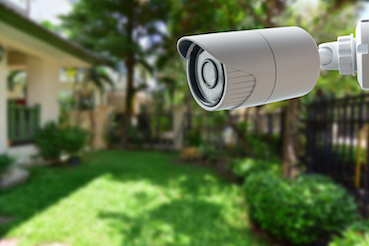What Is The Difference Between Indoor And Outdoor Cameras?

- The main differences between indoor and outdoor security cameras are size, durability, weather resistance, recording ability, installation, tamper proof, and connectivity.
- Safelink Security Systems has numerous indoor and outdoor security cameras to fit your home or building’s specific needs.
Security cameras have become an essential part of safeguarding our homes and businesses. When considering security camera systems, it’s crucial to understand the differences between indoor and outdoor cameras. Each type serves distinct purposes and are designed to meet specific environmental challenges. Understanding the differences between indoor and outdoor cameras is essential when choosing the right security solution for your property. Indoor cameras prioritize aesthetics and ease of installation, while outdoor cameras focus on durability, weather resistance, and tamper proof features. But let’s not get ahead of ourselves. Keep reading to find out the main difference between indoor cameras and outdoor cameras.
The 7 Main Differences Between Indoor Cameras & Outdoor Cameras
In comparing indoor and outdoor security cameras, a crucial distinction lies in their weatherproofing capabilities. Indoor cameras are designed for use inside homes and offices, where extreme temperature resistance isn’t a primary concern. However, outdoor cameras are built to endure the elements, withstanding scorching sun, rain, or snow. This weather-resistant feature ensures outdoor cameras remain functional and reliable in various outdoor conditions. Below we go into more detail about the main differences.
1. Size
One of the primary differences between indoor and outdoor cameras is their size. Indoor cameras are typically smaller and more compact, designed to blend seamlessly with interior décor. They are often less conspicuous and can be placed discreetly in various locations within a home or office.
Whereas outdoor cameras tend to be larger and more robust. They are often built with visible deterrent features, such as a visible housing or infrared LED lights, to discourage potential intruders.
2. Durability
Due to their intended use in controlled environments, indoor cameras may not be built to withstand harsh conditions or extreme temperatures. They are designed to operate in a climate-controlled setting, ensuring optimal performance and longevity.
Outdoor cameras, on the other hand, are built to withstand exposure to the elements, including rain, snow, and extreme temperatures. They are equipped with weather-resistant materials and robust construction to ensure they continue to function flawlessly in varying weather conditions.
3. Weather Resistance
Building on the previous point, outdoor cameras are specifically engineered to be weather-resistant. They come with an IP (Ingress Protection) rating that indicates their ability to resist dust and water intrusion. For example, an IP66-rated outdoor camera is protected against heavy rain and dust, making it suitable for outdoor installation.
Indoor cameras may not have a weather resistance rating as they are not exposed to the same environmental challenges.
4. Recording Ability
Indoor cameras are often designed for continuous recording, particularly for monitoring activities inside the premises. They may come with features like motion detection or sound sensors to trigger recording when activity is detected.
Outdoor cameras may also offer continuous recording, but they are more likely to be equipped with advanced motion detection technology to minimize unnecessary recording triggered by natural movements like leaves rustling or animals passing by. This helps conserve storage space and makes it easier to review relevant footage.
5. Installation
Indoor cameras are typically designed for simple and easy installation. They can be placed on flat surfaces or mounted to walls or ceilings using brackets. Indoor cameras often rely on power outlets for electricity.
Outdoor cameras, due to their more complex nature and the need to endure weather conditions, may require professional installation. They may need to be mounted higher up, come with more secure mounting options, and require special considerations for running power and data cables.
6. Connectivity
Both indoor and outdoor cameras can be wired or wireless, but the connectivity requirements may vary. Indoor cameras often have the option for Wi-Fi connectivity, making them easier to set up and relocate. Wired options are also available for more reliable connections.
Outdoor cameras may be wireless but are more likely to be wired due to their need for consistent power and connection stability. Wired outdoor cameras are less susceptible to interference and can provide uninterrupted surveillance.
7. Tamperproof
Indoor cameras may not have extensive tamper proof features, as they are typically installed in controlled environments where tampering is less likely.
Outdoor cameras, on the other hand, often come with additional tamperproof measures to prevent vandalism and tampering attempts. This can include features like anti-tamper screws and vandal-resistant housings.
Choose Safelink Security Systems for Your Indoor & Outdoor Security Cameras
Regardless of if you choose indoor security cameras, or outdoor security cameras, our #1 priority is to keep you and your property safe. When it comes to securing your property, Safelink Security Systems is a reliable and experienced provider of indoor and outdoor security cameras. We offer a wide range of high-quality surveillance solutions tailored to meet your specific needs. Safelink Security Systems provides expert installation services for outdoor cameras, ensuring that they are placed strategically to maximize coverage and deter potential intruders effectively. For indoor camera solutions, our team can help you choose the right cameras and locations to monitor your home or business seamlessly. With Safelink Security Systems, you can have peace of mind knowing that your property is under the watchful eye of top-of-the-line security cameras, protecting what matters most to you.
When you are ready to install cameras, motion sensors, window/door contacts, alarm systems, and other equipment to keep your home safe, choose Safelink Security Systems to provide the best equipment, best installation, best service, & best alarm monitoring.
Contact Safelink Security Systems
Phone: (405) 509-5465